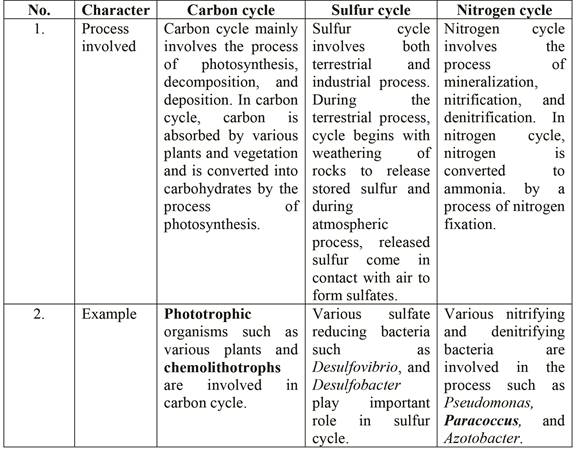
Concept explainers
Compare and contrast the carbon, sulfur, and nitrogen cycles in terms of the physiologies of the organisms that participate in the cycle. Which physiologies are part of one cycle but not another?
To explain:
The differences between carbon, sulfur, and nitrogen cycle in terms of physiologies of organisms involved in the cycle. Also, explain which physiologies are parts of one cycle but not of other.
Concept introduction:
Carbon cycle may be defined as the biogeochemical cycle in which carbon is exchanged among the biosphere, hydrosphere, geosphere, pedosphere, and atmosphere present on earth. Nitrogen cycle may be defined as a complex biogeochemical cycle by which atmospheric nitrogen is converted into various useful forms important to industrial and biological processes. Sulfur cycle may be defined as the collection of various processes by which cycling of sulfur occurs to and from the rocks, waterways, and the living system.
Explanation of Solution
The differences between carbon, sulfur, and nitrogen cycle are described as below:

Physiology of all three cycle differs from each other in several respects. Physiology of carbon cycle is very different than nitrogen or sulfur cycle as it involves the process of photosynthesis which requires light for completion of carbon cycle. Such requirement is not at all required in nitrogen or sulfur cycle. Also, symbiotic nitrogen cycle is different than sulfur or carbon cycle as it requires symbiotic association with organisms. This type of association is not required in carbon or sulfur cycle.
Want to see more full solutions like this?
Chapter 21 Solutions
Brock Biology of Microorganisms (15th Edition)
Additional Science Textbook Solutions
Campbell Biology in Focus
Genetic Analysis: An Integrated Approach (2nd Edition)
Human Biology: Concepts and Current Issues (8th Edition)
Biological Science
Human Physiology: An Integrated Approach (7th Edition)
Campbell Biology: Concepts & Connections (8th Edition)
- Make a diagram showing the interconnection between carbon and nitrogen cycle. Indicate possible microorganisms (scientific name) involved in each process.arrow_forwardWhat would happen if all microorganisms were to vanish from the nitrogen cycle? Give an explanation for your response.arrow_forwardList the main features of the nitrogen cycle.arrow_forward
- DESCRIBE THE ROLE OF MICROORGANISMS IN CARBON CYCLING. ILLUSTRATE CARBON CYCLING. DEFINE BIOREMEDIATION. DISCUSS THE TECHNIQUES, CLASSIFICATION, TECHNIQUES, BENEFITS, LIMITATIONS, AND PROSPECTS. HOW BIOREMEDIATION WORKS. DISCUSS THE DIFFERENT FACTORS AFFECTING BIOREMEDIATION. DESCRIBE THE INTERACTIONS BETWEEN HETEROTROPHS AND AUTOTROPHS IN THE CARBON CYCLE. WHAT ARE THE DIFFERENT WASTE TREATMENT SYSTEMS AND HOW DOES IT WORKS? DISCUSS THE IMPACT OF MICROBIAL DEGRADATION ON HUMANS. MAKE TABULAR DATA SHOWING THE ABILITY OF MICROORGANISMS PRESENT IN THE ENVIRONMENT THAT ARE CAPABLE OF DEGRADING PETROLEUM PRODUCTS. EXPLAIN THE COMPLEX ROLE OF MICROORGANISMS IN THE FORMATION OF VARIOUS CARBONATES AND IN THE FORMATION OF STROMATOLITES.arrow_forwardexplain the nitrogen cycle processarrow_forwardExplain the concepts cycling and nitrogen circulation in brief?arrow_forward
- List and define four different terms that describe an organism’s sources of carbon and energy.arrow_forwardWhat is the nitrogen cycle? (This question is asking for a general overview)arrow_forwardA characteristic of the open-loop system is that it does not use feedback to determine if its output has achieved the desired goal of the input. This means that the system does not observe the output of the processes that it is controlling. Closed-loop systems employ feedback and a reference of correctness. Deviations from the norm are detected and corrections made in order to maintain a desired output. 3) The image shown above is the Carbon cycle. What kind of system is the Carbon cycle? A) open-loop system B) closed-loop system C) unregulated system D) unchecked feedback system not gradedarrow_forward
- Draw out the the eight parts of the nitrogen cycle. Explain each of the parts with 2 sentences.arrow_forwardLabel the steps that contribute to the nitrogen cyclearrow_forwardMake a simple diagram or drawing (arrows only if you want to) the interconnection of carbon and nitrogen cycle. Also, write the microorganisms (Scientific names) involved in each process. Thank you!arrow_forward
 Human Anatomy & Physiology (11th Edition)BiologyISBN:9780134580999Author:Elaine N. Marieb, Katja N. HoehnPublisher:PEARSON
Human Anatomy & Physiology (11th Edition)BiologyISBN:9780134580999Author:Elaine N. Marieb, Katja N. HoehnPublisher:PEARSON Biology 2eBiologyISBN:9781947172517Author:Matthew Douglas, Jung Choi, Mary Ann ClarkPublisher:OpenStax
Biology 2eBiologyISBN:9781947172517Author:Matthew Douglas, Jung Choi, Mary Ann ClarkPublisher:OpenStax Anatomy & PhysiologyBiologyISBN:9781259398629Author:McKinley, Michael P., O'loughlin, Valerie Dean, Bidle, Theresa StouterPublisher:Mcgraw Hill Education,
Anatomy & PhysiologyBiologyISBN:9781259398629Author:McKinley, Michael P., O'loughlin, Valerie Dean, Bidle, Theresa StouterPublisher:Mcgraw Hill Education, Molecular Biology of the Cell (Sixth Edition)BiologyISBN:9780815344322Author:Bruce Alberts, Alexander D. Johnson, Julian Lewis, David Morgan, Martin Raff, Keith Roberts, Peter WalterPublisher:W. W. Norton & Company
Molecular Biology of the Cell (Sixth Edition)BiologyISBN:9780815344322Author:Bruce Alberts, Alexander D. Johnson, Julian Lewis, David Morgan, Martin Raff, Keith Roberts, Peter WalterPublisher:W. W. Norton & Company Laboratory Manual For Human Anatomy & PhysiologyBiologyISBN:9781260159363Author:Martin, Terry R., Prentice-craver, CynthiaPublisher:McGraw-Hill Publishing Co.
Laboratory Manual For Human Anatomy & PhysiologyBiologyISBN:9781260159363Author:Martin, Terry R., Prentice-craver, CynthiaPublisher:McGraw-Hill Publishing Co. Inquiry Into Life (16th Edition)BiologyISBN:9781260231700Author:Sylvia S. Mader, Michael WindelspechtPublisher:McGraw Hill Education
Inquiry Into Life (16th Edition)BiologyISBN:9781260231700Author:Sylvia S. Mader, Michael WindelspechtPublisher:McGraw Hill Education





